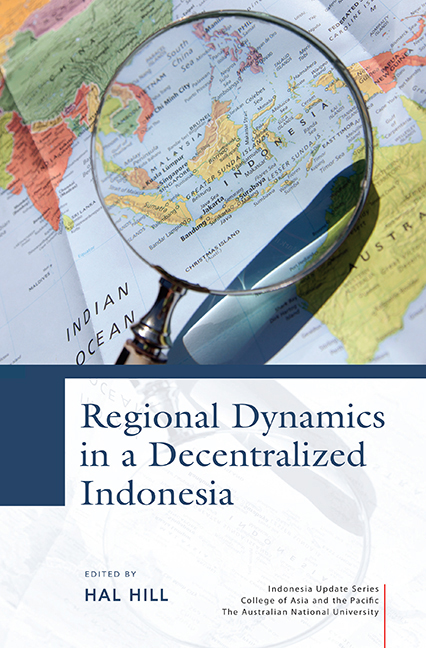Book contents
- Frontmatter
- Dedication
- Contents
- Tables
- Figures
- Contributors
- Acknowledgments
- Glossary
- Map of Indonesia
- 1 An introduction to the issues
- PART 1 HISTORICAL, ECONOMIC, POLITICAL AND SOCIAL PATTERNS
- PART 2 DECENTRALIZATION AND GOVERNANCE
- PART 3 LOCAL-LEVEL PERSPECTIVES
- PART 4 MIGRATION, CITIES AND CONNECTIVITY
- PART 5 CHALLENGES FOR INDONESIA'S PERIPHERY
- Author index
- Subject index
- INDONESIA UPDATE SERIES
1 - An introduction to the issues
Published online by Cambridge University Press: 21 October 2015
- Frontmatter
- Dedication
- Contents
- Tables
- Figures
- Contributors
- Acknowledgments
- Glossary
- Map of Indonesia
- 1 An introduction to the issues
- PART 1 HISTORICAL, ECONOMIC, POLITICAL AND SOCIAL PATTERNS
- PART 2 DECENTRALIZATION AND GOVERNANCE
- PART 3 LOCAL-LEVEL PERSPECTIVES
- PART 4 MIGRATION, CITIES AND CONNECTIVITY
- PART 5 CHALLENGES FOR INDONESIA'S PERIPHERY
- Author index
- Subject index
- INDONESIA UPDATE SERIES
Summary
THE ISSUES
In 2001, Indonesia embarked on a ‘big bang’ decentralization involving a major transfer of administrative, political and financial authority primarily to the district/municipality (kabupaten/kota) level of government. Together with the rapid transition from authoritarian to democratic rule in the late 1990s, this initiative has transformed the country's political, social and business life. While national government remains the major area of contestation, power has shifted irreversibly away from the centre. How this significantly increased regional autonomy works will have a crucial bearing on the future of the Indonesian nation-state. This volume, featuring contributions by 43 authors, provides a timely, comprehensive and analytical assessment of the country's regional development dynamics in the post-decentralization environment.
The regions (daerah) are central to an understanding of modern Indonesia. With its 17,000 islands stretching across three time zones, Indonesia is the world's largest archipelagic state. It features enormous diversity in its economy, ecology, ethnography, demography and much else. At the district level, for example, the richest region has a per capita income more than 50 times that of the poorest. Were they independent states, some parts of Indonesia would be classified as upper middle-income states, comparable to much richer Malaysia and Thailand, while other regions would be in the least developed group of extremely poor states. The policy and intellectual paradigms in and on Indonesia reflect this diversity. It is the key sentiment in the national motto, ‘Unity in diversity’ (‘Bhinneka tunggal ika’). Indonesians worry about the preservation of territorial integrity and national unity to an extent that may surprise outsiders unfamiliar with the country's struggle to create a new nation-state. After all, Indonesia did not formally exist as an entity until 1945, or even in the imagination of the nation's independence leaders until the early twentieth century. In fact, it came into existence in part as a result of lines drawn arbitrarily on a map in far-off European metropolitan capitals. Given the colonial history of divide-and-rule tactics, Indonesians are often shocked by the seemingly innocuous observation to the effect that ‘A glance at a map might seem enough to suggest the improbability of Indonesia’ (Cribb 1999: 3).
- Type
- Chapter
- Information
- Regional Dynamics in a Decentralized Indonesia , pp. 1 - 22Publisher: ISEAS–Yusof Ishak InstitutePrint publication year: 2014

